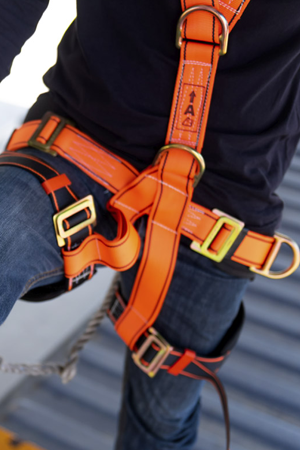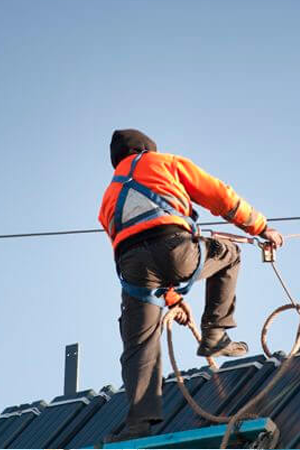In accordance with UK guidelines, the ‘3 points of contact’ rule is seen as sufficient when climbing ladders, the rule was mainly aimed at temporary ladder access (step ladders, extension ladders, etc) to increase the safety of the user. While this method is known to offer stability and support, thereby reducing the likelihood of slipping and falling’, this does not minimise this number to zero.
On permanent fixed ladders work areas, risk assessments should be made as to whether the 3 point of contact rule is the safest method of climbing the ladder, the following should be considered:
Ultimately, the more your team climbs, the more at risk your team is. In turn, this increases the likelihood of accidents. Not only does this heighten the risk of serious injury, but will create shutdowns and assessments for you and your team, costing your business a lot in both money and wasted time.
So, what are the alternatives to ensure your team is safe?
One of the most common approaches, the twin lanyard is a fall reduction method when climbing the ladder, whilst climbing the ladder, the twin lanyards are connected to the ladder rungs above head height, and the climber repositions the hooks of the twin lanyard as they are climbing the ladder to create a fall arrest point, the twin lanyard allows the person climbing to stay connected with one leg of the lanyard, whilst the second leg is being re-positioned and vice versa. If a fall occurs, the lanyard acts as an arresting point.

This common approach will restrict your team members from falling from height but leads to people breaking the 3 points of contact rule due to fatigue.
Ultimately, there are two main issues with this approach:
While it does help to prevent a fall, it requires you to routinely take your hands off the ladders to swap twin lanyard hooks from past rungs to the ones above you, this procedure puts a greater strain on the climber’s upper body, arms and shoulders, In turn, these moments add an increased risk of injury or failure in the system, as the climber becomes fatigued.
This issue can become heightened, however, depending on the user's current situation. After a long day at work, or if they’re stressed and experiencing fatigue from any external factors, ultimately they may not be as safe or rigorous when transferring their lanyards.
The use of the twin lanyard method, greatly increases the time it normally takes to climb up and down the ladder, this, along with the strain and fatigue of the twin lanyard procedure, can lead to complacency, and the climber opting for the easier option of not using this method and climbing the ladder without any form of fall protection.
If you slip, a twin lanyard won’t arrest your fall instantly. As this is a fall arrest system, dependant on the length of the twin lanyard the person climbing the ladder is susceptible to fall between 1 metre to 1.5 metres, plus any deployment from the lanyard shock absorber creating a greater injury risk.
Until the harness kicks in, the user will have built up quite a bit of momentum. While this does decrease the likelihood of falling the full height, it will increase the chances of minor injury, specifically in the thighs and groin which bears the weight when in a harness, as well as concussion if they fall into the ladder cage.
A fall arrest system provides workers with the ability to freely move on their ladder. If they were to fall, however, the system would activate, leaving your team member suspended from a height.

When used correctly, these can be less tiring for your team, as they clip-on at the bottom of the ladder and clip off at the top once you’re at the platform. Plus, they give you the peace of mind that if you do slip, there is no risk of freefalling, unlike the two-lanyard approach.
A fall arrest system also allows both of your hands to be free while climbing, giving you and your team the ability to also follow the 3 points of contact system and other ladder safety techniques, further minimising the opportunity for injury to occur.
So, if the 3 points of contact system doesn’t ensure ladder safety, what does?
While there are a variety of safety measures you can put in place to help protect your workers from injury, ultimately the easiest way to ensure their safety is to eliminate the height altogether.
As you plan what needs to be done in order to complete your tasks, where possible, do as much on the ground as possible. Whether it’s creating the frame on the ground or utilising new technology for previous, in-person checks at height, by doing the majority of your work on the ground you’ll be guaranteeing the safety of your team by removing the chance of falling from a height altogether.
If you do have to work at height, however, ensure the ladder safety techniques you have in place are used alongside the 3 points of contact rule to minimise the potential for serious injury.
Ultimately, simply having the 3 points system isn’t enough to ensure the safety of you and your team.
When enforcing and planning a ladder safety plan for your worksite, don’t rely on the 3 points of the contact system. Although it does keep your workers safe a majority of the time, when you are most relaxed on-site, you are the most susceptible to injury.
Don’t let your high standards fall.
Ready to learn more? Download your copy of The No-Nonsense Guide To The Working at Height Regulations to learn how to plan for working at height and stay compliant without the headache.
Get our expert knowledge delivered straight to your inbox, and keep up-to-date with the latest goings on in your industry.
Falls from a height continue to be the most common kind of fatal injury in the workplace for the 4th year running - with 171 fatal injuries from 2016-2021 being due to falls from a height. You may be ...
In 2005, the Work at Height Regulations (2005) were introduced to ensure the safety of those who work at potentially dangerous heights and they are still in place today. What does all this legal jargo...
According to HSE, you should be taking vital steps to protect your team when working at height. One way to minimise the likelihood of an accident is through the use of a Fall Arrest System.